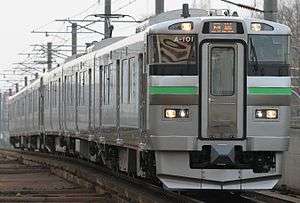735 series
The 735 series (735系) is an electric multiple unit (EMU) train type built in 2010 and operated by Hokkaido Railway Company (JR Hokkaido) on suburban services in the Sapporo area in Hokkaido, Japan, since May 2012.
| 735 series | |
|---|---|
 Sets A-101 and A-102, May 2012 | |
| In service | May 2012 |
| Manufacturer | Hitachi |
| Built at | Kudamatsu |
| Constructed | 2010 |
| Number built | 6 vehicles (2 sets) |
| Number in service | 6 vehicles (2 sets) |
| Formation | 3 cars per trainset |
| Fleet numbers | A-101–102 |
| Capacity | 428 (148 seated) |
| Operator(s) | JR Hokkaido |
| Depot(s) | Sapporo |
| Specifications | |
| Car body construction | Aluminium alloy |
| Car length | 21,200 mm (69 ft 7 in) (end cars), 20,800 mm (68 ft 3 in)(intermediate cars)[1] |
| Width | 2,800 mm (9 ft 2 in) |
| Doors | 3 per side |
| Maximum speed | 120 km/h (75 mph)[2] |
| Acceleration | 2.2 km/h/s[2] |
| Electric system(s) | 20 kV AC |
| Current collection method | Overhead catenary |
| Bogies | N-DT735 (motored), N-TR735 (trailer) |
| Multiple working | 721 series, 731 series, 733 series |
| Track gauge | 1,067 mm (3 ft 6 in) |
Design
The 735 series is intended as an experimental type to evaluate the suitability of aluminium-body rolling stock in the cold climate of Hokkaido. The cab ends however use steel construction. They were tested in winter conditions from 2010 to 2011.[2]
The 735 series sets are able to run in multiple with 721 series, 731 series, and 733 series suburban EMUs, but not with KiHa 201 series DMUs.[2][3]
Formation
Sets are formed as shown below.[2]
| Car No. | 1 | 2 | 3 |
|---|---|---|---|
| Designation | Tc1 | M | Tc2 |
| Numbering | KuHa 735-100 | MoHa 735-100 | KuHa 735-200 |
| Weight (t) | 31.8 | 40.1 | 33.3 |
| Capacity (total/seated) |
137/46 | 150/52 | 141/50 |
The MoHa 735 car is fitted with an N-PS785 single-arm pantograph.[2]
 KuHa 735-102
KuHa 735-102 MoHa 735-102
MoHa 735-102 KuHa 735-202
KuHa 735-202
Interior
The 735 series design continues the basic configuration of the earlier 731 series with longitudinal seating throughout. The floor is 100 mm lower than on previous trains, for improved accessibility. Car 1 has a universal access toilet.[2]
 Interior view, August 2010
Interior view, August 2010
History

Two 3-car sets were delivered from the Hitachi factory in Yamaguchi Prefecture in March 2010.[4]
The sets first entered revenue-earning service on 1 May 2012.[5]
References
- "JR北海道 735系通勤型交流電車" [JR Hokkaido 735 series commuter EMU]. Tetsudō Daiya Jōhō Magazine. 39 (314): 68–69. June 2010.
- Izumi, Hiroyuki (June 2010). "735系通勤形交流電車" [735 series AC commuter EMU]. Japan Railfan Magazine. 50 (590): 62–65.
- "JR北海道 733系通勤型交流電車" [JR Hokkaido 733 series AC commuter EMU]. Tetsudō Daiya Jōhō Magazine. 41 (337): 69. May 2012.
- Tetsudō Daiya Jōhō Magazine. 39 (311): 126. March 2010.CS1 maint: untitled periodical (link)
- "JR北海道735系電車が営業運転を開始" [JR Hokkaido 735 series enters revenue service]. Japan Railfan Magazine Online (in Japanese). Japan: Koyusha Co., Ltd. 2 May 2012. Retrieved 2 May 2012.
External links
| Wikimedia Commons has media related to 735 series. |
- JR Hokkaido press release (10 March 2010) (in Japanese)
- JR Hokkaido 735 series (Japan Railfan Magazine Online) (in Japanese)